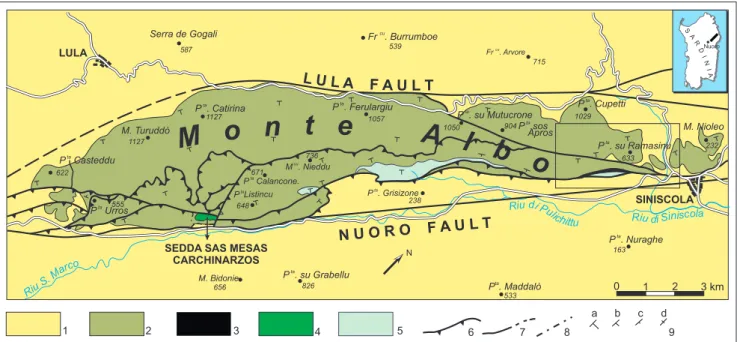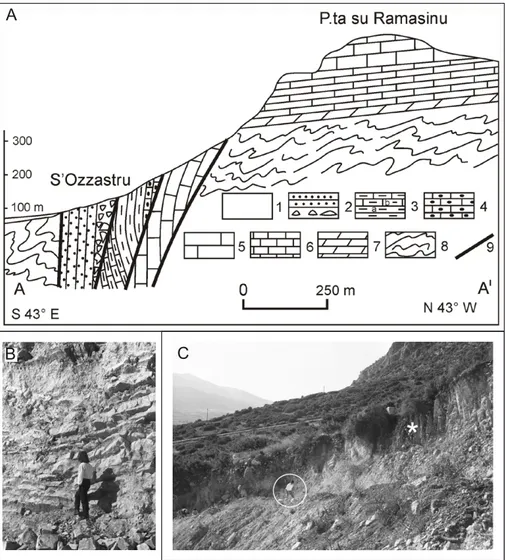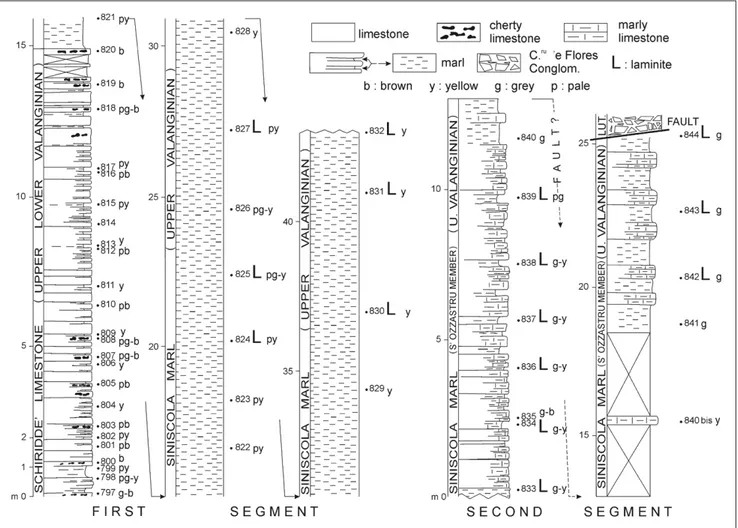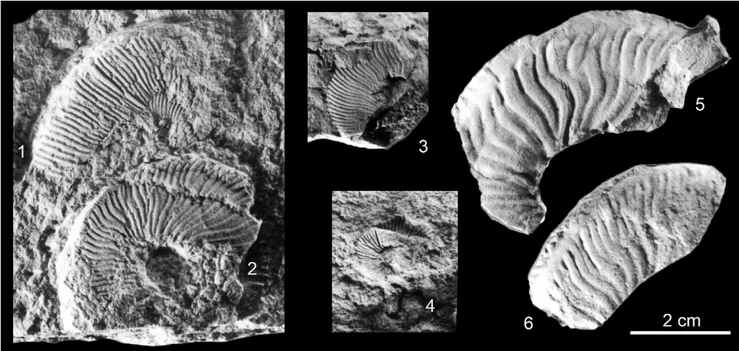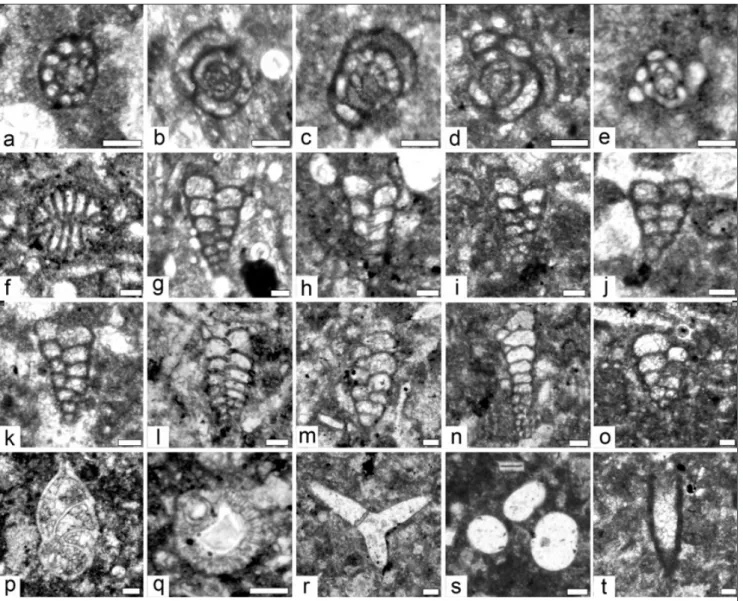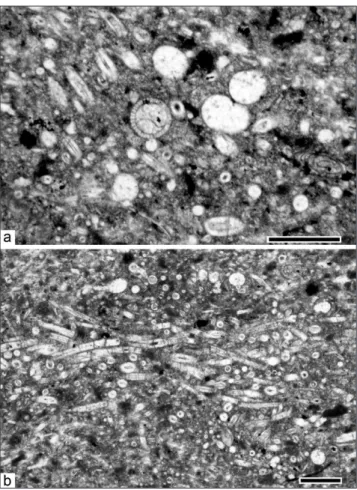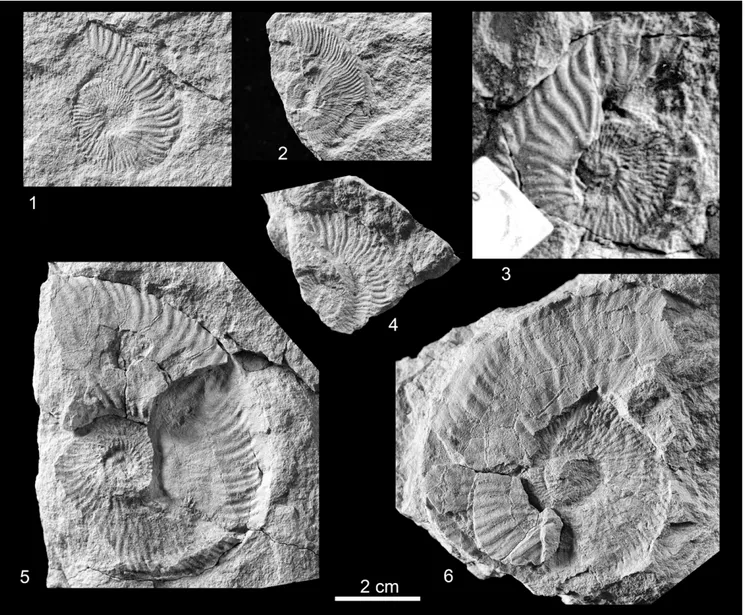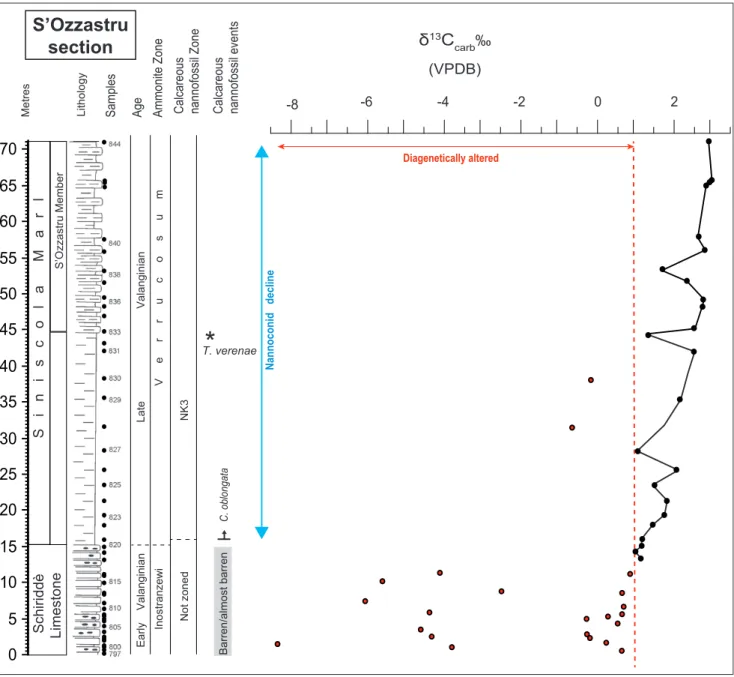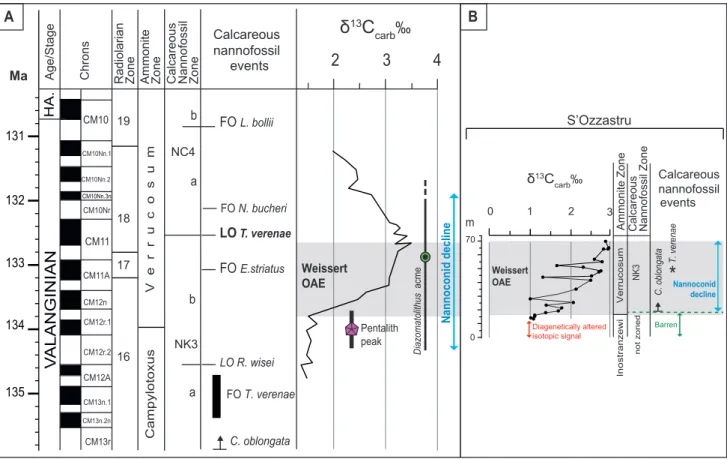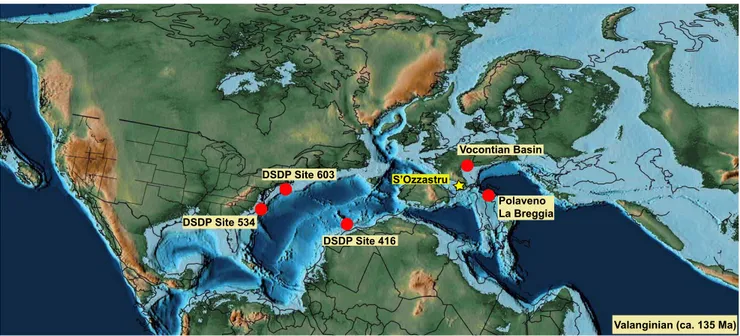THE VALANGINIAN WEISSERT OCEANIC ANOXIC EVENT RECORDED IN CENTRAL-EASTERN SARDINIA (ITALY)
CINZIA BOTTINI1*, IGINIO DIENI2, ELISABETTA ERBA1, FRANCESCO MASSARI2 & HELMUT WEISSERT3
1*Corresponding author. Dipartimento di Scienze della Terra “A. Desio”, Università degli Studi di Milano, Via Mangiagalli, 34, I-20133 Milano,
Italy. E-mail: [email protected]; [email protected]
2Dipartimento di Geoscienze, Università degli Studi di Padova, Via Gradenigo, 6, I-35131 Padova, Italy. E-mail: [email protected] 3Department of Earth Sciences, Geology, ETH-Zürich, Sonneggstrasse 5, CH-8092 Zürich, Switzerland. E-mail: [email protected]
To cite this article: Bottini C., Dieni I., Erba E., Massari F. & Weissert H. (2018) - The Valanginian Weissert Oceanic Anoxic Event recorded in central-eastern Sardinia (Italy). Riv. It. Paleontol. Strat., 124(3): 617-637.
Rivista Italiana di Paleontologia e Stratigrafia (Research in Paleontology and Stratigraphy)
vol. 124(3): 617-637. November 2018
Abstract . Investigations on the S’Ozzastru section from the northern part of the Mt Albo area (central-eastern
Sardinia, Italy) for integrated litho- bio- and chemostratigraphy allowed the identification of the Valanginian Weissert Oceanic Anoxic Event (OAE), testified by a positive carbon isotope excursion (CIE). The section, which represents the deepest-water succession of the Valanginian in Sardinia, is composed of the Schiriddè Limestone followed by the Siniscola Marl, both proposed as new lithostratigraphic units. The presence among the ammonites of Busnardoites campylotoxus allows the attribution of the Schiriddè Limestone to the upper Lower Valanginian Inostranzewi Zone of
Reboulet et al. 2014. Further characterization of this unit was not possible since it is barren/almost barren of nanno-fossils. The Siniscola Marl can be ascribed to the lower Upper Valanginian on the basis of the ammonite fauna indicat-ing the Verrucosum Zone, and of the nannofossil content suggestindicat-ing the Zone NK3. The carbon isotope record in the Siniscola Marl is characterized by a positive excursion with values up to 2.98 ‰. In the nannofossil assemblages, nannoconids are not particularly abundant and are found, among others, together with C. oblongata, D. lehmanii, and
pentaliths.The scarcity of nannoconids is regarded as a biostratigraphic support for the identification of the Weissert OAE, as it possibly reflects the “nannoconid decline” interval which characterizes this event. The end of the Weissert OAE CIE is not recorded probably because of suppression of the upper part of the succession for tectonic causes.
Received: February 02nd, 2018; accepted: October 01st, 2018
Keywords: Valanginian; Weissert Oceanic Anoxic Event; lithostratigraphy; biostratigraphy; Carbon isotopes.
I
ntroductIonThe Valanginian is characterized by a glob-ally recorded positive C isotope excursion (CIE) which reflects an episode of carbon cycle pertur-bation associated with profound variations in cli-matic and palaeoceanographic conditions. This positive CIE was first detected in successions from the Tethys Ocean (Weissert 1989) and further in-vestigations demonstrated its global significance in different locations (Lini et al. 1992; Channell et al. 1993; Hennig et al. 1999; Erba et al. 2004; Weissert & Erba 2004; Sprovieri et al. 2006; Duchamp-Al-phonse et al. 2007; Greselle et al. 2011; Kujau et al. 2013; Charbonnier et al. 2013; Morales et al. 2015;
Meissner et al. 2015) including terrestrial records (Gröcke et al. 2005). Palaeoceanographic studies in-dicated that the CIE coincided with a widespread eutrophication of marine ecosystems associated with platform drowning (Schlager 1981; Föllmi et al. 1994; Graziano 1999; Gradinaru et al. 2016), pe-lagic carbonate crisis (e.g. Lini et al. 1992; Bersezio et al. 2002; Reboulet et al. 2003; Erba and Tremo-lada 2004; Erba et al. 2004), and increased evolu-tionary rates in planktonic communities (Erba et al. 2004; Erba 2006, and reference therein). Erba et al. (2004) formalized the Valanginian event as the “Weissert Oceanic Anoxic Event” (OAE), defined on the basis of the δ13C curve being comprised be-tween the onset of the positive CIE and the high-est values of the isotopic excursion. Stratigraphic studies allowed to calibrate the Valanginian CIE with magnetostratigraphy and biostratigraphy (e.g.
Lini et al. 1992; Channell et al. 1993, 1995; Hen-nig et al. 1999; Bersezio et al. 2002; Reboulet et al. 2003; Erba et al. 2004; Duchamp-Alphonse et al. 2007; Bornemann & Mutterlose 2008; Charbonni-er et al. 2013), and highlighted coeval changes in fossil assemblage composition and abundance of different marine fossil groups. These biotic chang-es included the decline in nannoconid abundance, called “nannoconid decline’’, whose onset predated the positive CIE (Channell et al. 1993; Bersezio et al. 2002; Erba & Tremolada 2004; Erba et al. 2004; Duchamp-Alphonse et al. 2007; Bornemann & Mutterlose 2008; Greselle et al. 2011; Barbarin et al. 2012; Mattioli et al. 2014), and coincided with a peak in pentalith abundance (Bersezio et al. 2002; Erba & Tremolada 2004) and the beginning of in-creased abundance of Diazomatolithus evidenced in
Tethyan sections and ODP Site 1149 (Bersezio et
al. 2002; Erba & Tremolada 2004; Erba et al. 2004). The “nannoconid decline” was explained as the nannoplankton response to the global nutrification episode that occurred over the onset of the OAE (Bersezio et al. 2002; Erba & Tremolada 2004; Erba et al. 2004; Bornemann & Mutterlose 2008; Mat-tioli et al. 2014) linked to major igneous/tectonic events of the Paranà-Etendeka igneous province. The volcanic activity was identified as the principal cause of altered oceanic/atmospheric conditions (e.g. Lini et al. 1992; Channell et al. 1993, Weissert et al. 1998; Bersezio et al. 2002; Erba & Tremolada 2004; Martinez et al. 2015; Charbonnier et al. 2016, 2017), possibly responsible for increased pCO2 in the atmosphere and consequent accelerated hydro-logical cycling (e.g. Weissert 1989; Lini et al. 1992; Föllmi et al. 1994; Weissert et al. 1998; Erba et al. 2004) during the initial phase of OAE. In addition, higher surface water fertility was also suggested to have been induced by the input of biolimiting met-als due to increased spreading rates and hydrother-mal activity (Lini et al. 1992; Channell et al. 1993; Weissert et al. 1998; Bersezio et al. 2002; Erba et al. 2004; Bornemann & Mutterlose 2008). Under en-hanced primary productivity, the carbon burial pro-cess was accelerated (Channell et al. 1993; Weissert et al. 1998), locally favoring the onset of oceanic dysoxia/anoxia with black shales deposition (Erba et al. 2004). Reconstructed climatic conditions over the Weissert OAE indicate general cooler tempera-ture with a cooling registered in correspondence of the final phase of OAE (e.g. Kemper 1987;
Mut-terlose & Kessels 2000; MutMut-terlose et al. 2003; Re-boulet et al. 2003; Greselle et al. 2011; Barbarin et al. 2012; Mattioli et al. 2014).
The purpose of this study is to characteri-ze through integrated litho-, bio- and chemostra-tigraphy the Mt Albo succession (central-eastern Sardinia) and detect evidence of the Valanginian Weissert OAE in Sardinia. The Mt Albo area re-cords Valanginian sediments of relatively deep wa-ter settings and their stratigraphic characwa-terization may constitute the background for further palaeo-geographic and palaeoenvironmental studies of the Lower Cretaceous deposits of the island. We pro-vide a detailed geological and stratigraphic setting which includes new data necessary to frame the Va-langinian deposits of Sardinia in a wider palaeoge-ographic context. The data of which the literature sources are not reported, are to be regarded as new.
MaterIal and Methods
In this work we focus on the S’Ozzastru quarry section sit-uated near the village of Siniscola, in proximity of the northern ter-mination of the Mt Albo. Field work included a partial updating of the Mt Albo geological map published by Dieni & Massari in 1971, identification and characterization of the lithostratigraphical units, and sedimentological observations on the measured and sampled sections (Figs 1- 3; Pl. 1). Furthermore, the S’Ozzastru section has been analyzed for integrated litho-, bio-, and chemostratigraphy.
G
eoloGIcalsettInG andstratIGraphyThe study area is located in central-eastern Sardinia, where the sedimentary cover of the Pal-aeozoic metamorphic substrate is represented by a Middle Jurassic-Lower Cretaceous succession, mostly consisting of shallow-marine dolostones and limestones. The investigation is specifically focused on the Lower Cretaceous deposits of the Mt Albo, a fault-bounded massif elongated in a NE-SW direc-tion (Fig. 1). The Middle Jurassic-Lower Cretaceous succession of this massif shows remarkable facies variations, indicative of a north-easterly trend from inner and protected environments to more open and deeper sea. In the northern part (Pl. 1) quartz-arenitic brown dolostone evolving to ooidal dolos-tone of the Dorgali Formation (unit established by Amadesi et al. 1960) of Middle-Late Bathonian age are followed by fine-grained, well-bedded middle- to outer-ramp limestones and cherty limestones of
The Valanginian Weissert Oceanic Anoxic Event in central-eastern Sardinia (Italy) 619
latest Bathonian - earliest Tithonian age (S’Adde Limestone, formational name proposed by Dieni & Massari 1985, and formalised by Casellato et al. 2012), with hardgrounds in the lowermost part and cherty limestones in the upper part, contain-ing belemnites and ammonites particularly of the Upper Kimmeridgian Beckeri Zone (Dieni et al. 1966). This interval is followed by a thick carbonate platform complex of Early Tithonian to Late Ber-riasian age (Monte Bardia Limestone, formation established by Amadesi et al. 1960), consisting of thick-bedded to massive white limestones, mostly made up of biosparites and algal bindstones, and in places with patch reefs in the lower part (Dieni & Massari 1985, 1991), with corals, nerineids, Clypeina jurassica Favre in Joukovsky & Favre, 1927, Camp-belliella striata (Carozzi, 1954), Neoteutloporella so-cialis (Praturlon, 1963), Mohlerina basiliensis (Mohler,
1938), abundant Crescentiella morronensis (Crescenti,
1969), Koskinobullina socialis Cherchi & Schroeder,
1979, and “Bacinella-Lithocodium” boundstones.
Contrasting with the northern part of the Mt Albo massif, the southern part is characterized by a much thicker succession of dolostones of the Dorgali Formation, locally underlain by fluvio-del-taic quartz-conglomerates and sandstones (Genna
Selole Formation, Bajocian(?)-Lower Bathonian; Dieni & Massari in Dieni et al. 1983), and in places including limestone lenses particularly rich in infau-nal bivalves, usually in life position [among which
Pholadomya lirata (J. Sowerby, 1818), Ph. ovalis (J.
Sow-erby, 1819), Homomya gibbosa (J. Sowerby, 1813), Cer-atomya concentrica (J. de C. Sowerby, 1825)], and with
brachiopods (including Burmirhynchia turgida
Buck-man, 1917) of Middle-Late Bathonian age. This
succession is followed upwards in apparent continu-ity by the Tithonian Monte Bardia Limestone with
Clypeina jurassica and Campbelliella striata, represented
here by back-ramp lagoonal and protected-flat lime-stones with stromatolite horizons.
Tithonian-Berriasian deposits were formed on a carbonate platform with a spectrum of vari-able environments. In the northern Mt Albo mas-sif, platform-margin limestones predominate in the upper Monte Bardia Limestone, where they mostly consist of bioclastic sediments including various microencrusters such as “Bacinella-Lithocodium”
boundstone and Crescentiella morronensis.
In the southern Mt Albo massif, the upper Monte Bardia Limestone includes in the Lower Ber-riasian a characteristic interval which is well docu-mented in central-eastern Sardinia [in the Orosei
N
1 2 3 4 5 6 7 8 9
a b c d
Fig. 1 - Geological sketch map of the Mt Albo massif. Legend: 1) Palaeozoic basement. 2) Bajocian(?) to Berriasian siliciclastic to carbonate succession (Genna Selole Fm., Dorgali Fm. and Monte Bardia Limestone). 3) Valanginian limestone and marl (Schiriddè Limestone and Siniscola Marl). 4) Valanginian to Lower Hauterivian limestone emplaced by palaeo-slide. 5) Middle Eocene Cuccuru ’e Flores Conglomerate. 6) Overthrust. 7) Fault. 8) Limit of palaeo-slide (Sedda sas Mesas – Carchinarzos). 9) Attitude and dip of beds (a= 20°- 40°; b= 41°- 60°; c= 61°- 80°; d= 81°- 90°). Quaternary deposits omitted. Inset shows the area of the geological map of Pl. 1 (From Dieni & Massari 1987, fig. 42, modified).
area (Mt Tuttavista) and extensively in the Oliena-Orgosolo-Urzulei “Supramonte” (e.g. Lanaittu area near Oliena; see Dieni & Massari 1985, fig. 3)]. It consists of predominant mud-cracked micritic laminites with intercalated layers of storm-related washover deposits and black pebble breccias (the latter resulting from fragmentation of blackened carbonate sediments rich in organic matter mostly formed in freshwater to brackish pools with reduc-ing conditions), correspondreduc-ing to the well-known “Purbeckian facies” of the literature. This interval contains oligotypic assemblages of charophytes, ostracods and small molluscs (among which planor-bid gastropods) suggesting a scenario of restricted environments of very shallow-water and temporar-ily emergent wide inter- to supratidal flats dissemi-nated with lagoonal to lacustrine ponds. Wholly similar Berriasian deposits indicating a regressive transition from the marine platform deposits of the Upper Tithonian to lagoonal-lacustrine “Pur-beckian” marls and limestones with charophytes and ostracods are also known in the Nurra area of NW Sardinia (Maxia & Pecorini 1963; Chabrier & Fourcade 1975; Colin et al. 1985). The facies as-sociation of these deposits points to a marked re-gressive trend which is consistent with a scenario of lowstand conditions, as generally observed in the uppermost Jurassic to Lower Berriasian succes-sions of the central and northern European area (Hallam 1986; Haq et al. 1987; Hallam et al. 1991; Abbink et al. 2001; Dera et al. 2011).
A sedimentary record of the Valanginian in central-eastern Sardinia is only known in the Mt Albo massif, in the Orosei area and in the Lanaittu valley (Oliena).
The Valanginian deposits cropping out in proximity of the northern termination of the Mt Albo, which are the focus of this paper, are signifi-cantly different in facies from those of adjacent ar-eas (see below) for their deeper-water depositional setting. The deposits appear tectonically squeezed between Upper Berriasian limestones, representing the last terms of the Monte Bardia Limestone, and Middle Eocene rudites and arenites of the Cuccu-ru ’e Flores Conglomerate (formation described by Dieni & Massari 1966 and formalized by Dieni et al. 2008) (Pl. 1 and Fig. 1). In central-eastern Sar-dinia the latter are commonly localized at the feet of fault scarps bounding the carbonate massifs and linked to the Cenozoic tectonics.
In general, the Lower Cretaceous depos-its are reduced in extension at the foot of the Mt Albo and appear as slices bounded by faults delim-iting the massif on its eastern side (Fig. 1). The faults are part of a transpressional system, which is a major, polyphase structural element of regional importance crossing the whole island. The differ-ent depositional setting, particularly comparing the marine and almost continuous succession of the northern Mt Albo (see below) to the incomplete sequences of the other areas, laid down in signifi-cantly shallower environments, may be interpreted to result from Tertiary transcurrent movements, which brought near to one another originally more spaced areas. This fault system was activated in the
Middle Eocene in an inferred foreland setting with respect to the Alpine orogen, and re-activated in the Late Oligocene – Early Miocene initial stages of the Apenninic history, when the Corsica-Sardin-ia microplate behaved as hinterland of the Apen-ninic migrating front (Dieni et al. 2008; Massari &
PLATE 1
Geologic map of the Siniscola area, central-eastern Sardinia (from Dieni & Massari 1971, updated in 1986).
Legend: 1) Recent and present alluvial deposits (Holocene). 2) Scree
de-posits; idem with boulders (Würm-Holocene). 3) Detrital cones
mostly composed of gelifraction limestone clasts (“éboulis ordonnés”) (Würm-Holocene). 4) Uncemented alluvial cones
mostly consisting of limestone clasts (Würm-Holocene). 5)
Terraced alluvial deposits composed of clasts of basement rocks (Riss?). 6) Tightly cemented and dismembered alluvial
cones mostly made up of gelifraction limestone clasts (Riss?).
7) Cuccuru ’e Flores Conglomerate: polymict, chaotic and thick-bedded breccia and stratified sandstone (Middle Eocene).
8) Siniscola Marl: grey and grey-yellow marl and, in the up-per part, alternating marl/marly limestone with ammonites and very abundant radiolarians and sponge spicules (Late Valanginian). 9) Schiriddè Limestone: light-brown cherty
limestone and limestone with marly interbeds, containing ammonites, radiolarians, sponge spicules and calpionellids (Early Valanginian). 10) Monte Bardia Limestone:
thick-bedded to massive white limestone in places bioconstructed, with corals, nerineids, etc. (Early Tithonian - Late Berriasian).
11) S’Adde Limestone: light-brown to grey fine-grained, well-bedded limestone, condensed with hardgrounds near the base, cherty in the upper part, with ammonites and bel-emnites in the uppermost part (latest Bathonian - earliest Ti-thonian). 12) Dorgali Formation: well bedded quartz-arenitic
and locally ooidal brown dolostone (Middle-Late Bathonian).
13) Metamorphic basement (phyllite, micaschist, paragneiss, quartzite, etc.) (Palaeozoic). 14) Fault. 15) Attitude of beds and
schistosity planes. 16) Limits of slumped masses of Jurassic formations (Quaternary). 17) Concave-upward slip surfaces
delimiting rotational slumps (Quaternary). 18) Edge of fluvial
terrace. 19) Quarry. 20) Trace of the geological section of Fig. 2A.
Dieni 2014). As a result of this polyhistory tecton-ics, the Mt Albo area was sliced in a number of mutually overlapping slivers involved in a positive flower structure, the last motion being represented by sinistral transpression (Dieni & Massari 1991, fig. 26; Carmignani et al. 1992) (Pl. 1; Figs 1 and 2A).
The Berriasian-Valanginian succession of Mt Albo
In the Mt Albo massif the Lower Cretaceous succession has been analyzed in the S’Ozzastru sec-tion (already briefly described by Dieni et al. 1987), located near the village of Siniscola, close to the northern corner of the massif (Pl. 1), and in the Sas Mesas-Carchinarzos section, located in the south-eastern part of the massif. The focus of this paper is specifically on the S’Ozzastru section, whereas the latter section has been taken into account for its sharp differences in the stratigraphy and facies association with respect to the former and was not analyzed for the nannofossil assemblages.
A - S’Ozzastru area
The last thirty metres of the carbonate plat-form complex of the Monte Bardia Limestone in the small Riu Siccu valley, located about 2.2 Km SW of S’Ozzastru (Pl. 1), are represented by platform-margin white biosparites with Coscinoconus ex gr. al-pinus-elongatus Leupold, 1935, Pseudocyclammina ex gr. lituus (Yokoyama, 1890), Protopeneroplis ultragranulata
(Gorbatchick, 1971), Montsalevia elevata Zaninetti,
Salvini-Bonnard & Charollais, 1987, Pseudocymopolia jurassica (Dragastan, 1968), Crescentiella morronensis, Favreina salevensis (Paréjas, 1948), associated with
rare calpionellids, including Calpionella alpina
Lo-renz, 1902, and C. cf. elliptica Cadisch, 1932 (see also
Azéma et al. 1978).
In the S’Ozzastru quarry section (Pl. 1) the above deposits grade upwards into light-brown bi-omicrites and intramicrites of about 10 m thickness (uppermost Monte Bardia Limestone) involved in the fault bundle affecting the Lower Cretaceous suc-cession in this area and showing therefore intense tectonic shearing. The microfaunal content includes
A
B C
Fig. 2 - A) Geological section across the S’Ozzastru area (trace A---A’ in the geological map of Pl. 1). Legend: 1) Recent and present alluvial deposits ( Ho-locene). 2) Cuccuru ’e Flores
Conglomerate: sandstone and breccia (Middle Eoce-ne). 3) Siniscola Marl: marl
(a) and marly limestone (b) (Late Valanginian). 4)
Schi-riddè Limestone: cherty li-mestone (Early Valanginian).
5) Monte Bardia Limestone: limestone (Early Tithonian - Late Berriasian). 6) S’Adde
Limestone: limestone and cherty limestone (latest Ba-thonian - earliest TiBa-thonian). 7)
Dorgali Formation: dolosto-ne (Middle-Late Bathonian). 8)
Metamorphic basement ( Pa-laeozoic). 9) Fault.
B) Overturned succession of the Schiriddè Limestone between beds 799 and 804 of the log, consisting of al-ternating cherty limestone and marl.
C) Transition (asterisk) from subvertical strata of the Schiriddè Limestone (right) to the Siniscola Marl, partly covered by scree deposits.
The Valanginian Weissert Oceanic Anoxic Event in central-eastern Sardinia (Italy) 623
Coscinoconus ex gr. alpinus-elongatus and P. ultragranula-ta, accompanied by common calpionellids, among
which Calpionellopsis simplex (Colom, 1939), Cps. oblonga (Cadisch, 1932), Praecalpionellites murgeanui
(Pop, 1974), in order of occurrence, and Calpionel-la alpina, RemanielCalpionel-la cadischiana (Colom, 1948), Tin-tinnopsella carpathica (Murgeanu & Filipescu, 1933),
and T. longa (Colom, 1953). This assemblage
indi-cates a Late Berriasian age (see Grün & Blau 1997, and references therein) which is confirmed by the presence, among the macrofossils, of the gastropod
Leviathania leviathan (Pictet & Campiche, 1863) [see
Decrouez in Zaninetti et al. 1988, where this taxon is described as Leviathania sautieri (Coquand, 1856);
we adopt here the junior specific name leviathan in
application of the I.C.Z.N. art. 59.3].
At the top of this succession a sharp litho-logic change, probably corresponding to a short stratigraphic gap of the uppermost Berriasian, indicated by the absence of Praecalpionellites dadayi
(Knauer, 1963) (see Grün & Blau 1997), marks the
transition to grey-light brown micritic and slightly marly, commonly bioturbated limestones of about 2 m thickness, with Calpionellites darderi (Colom,
1934), Praecalpionellites murgeanui, T. carpathica, and T. longa, indicating an Early Valanginian age.
The following yellowish cherty limestones about 15 m thick (reported in the lower part of the first segment of the log in Fig. 3) contain am-monites, including Olcostephanus sp., Busnardoites campylotoxus (Uhlig, 1910), B. cf. campylotoxus, Neo-comites neocomiensis (d’Orbigny, 1841), Teschenites cf. teschenensis (Uhlig, 1902) and Neohoploceras sp. juv. ?
(Fig. 4). This assemblage indicates the Inostranze-wi Zone of Reboulet et al. 2014 (= Campylotox-us Zone auctt.) of late Early Valanginian age (see
Reboulet et al. 2009, 2014, and references there-in). The microfossil assemblages are very rich in sponge spicules [reniform sterraster microscleres are particularly abundant, as in the entire interval of the log; Figs. 5 (s) and 6 (a)], associated with radiolarians, sparse benthic foraminifers [among
which Praedorothia praehauteriviana (Dieni &
Mas-sari, 1966), Protomarssonella hechti (Dieni &
Mas-sari, 1966), P. kummi (Zedler, 1961), Pseudotextulari-ella salevensis Charollais, Brönnimann & Zaninetti,
1966, Meandrospira favrei (Charollais, Brönnimann
& Zaninetti, 1966) [= Glomospirella gaultina
(Berthe-lin) in Dieni & Massari 1966, p. 85, pl. I,fig. 1, and pl. IX, fig. 1], Lenticulina crepidularis (Roemer, 1842), L. spp., Nodosaria sp., Rumanolina feifeli (Paalzow,
1932), Spirillina sp., polymorphinids], and Aeolisac-cus inconstans Radoičić, 1967 (Fig. 5). Local
lamina-tion and iso-orientalamina-tion of elongate sponge spic-ules suggest episodic bottom current activity (Fig. 6b). For the overall Lower Valanginian interval we propose the formational name of Schiriddè Limestone, with type-section in the S’Ozzastru
area (Figs 2B, 3).
This interval grades into grey marls (Fig. 2C) of about 30 m thickness, with laminated, sap-ropel-like layers (upper part of the first segment of the log in Fig. 3), passing to alternating dark-grey marls and marly limestones (yellowish where weathered) with iron sulfides and rich in organic matter and again with laminated, sapropel-like, in-tervals (second segment of the log, 25 m thick; Fig. 3). For this complex we propose the forma-tional name of Siniscola Marl, with type-section
again in the S’Ozzastru area (Fig. 3). The second
segment is separated in the log as a member, which
has been named S’Ozzastru Member. It should
be noted that the estimated thickness of the Siscola Marl is somewhat imprecise, due to the in-creasingly tectonized upper part of the succession, where the formation is in contact with the Eocene Cuccuru ’e Flores Conglomerate (Fig. 1) by means of the Nuoro fault system bounding the Mt Albo massif on the eastern side; as a result, the unit crops out in a limited, strip-like belt and is strongly sheared and steeply dipping (Pl. 1; Figs 2A, C).
The first segment of the Siniscola Marl yield-ed some ammonites, among which Neocomites neoco-miensis (d’Orbigny, 1841) and Neocomites platycostatus
Sayn, 1907 (Fig. 7). Concerning the age assignment,
N. neocomiensis is currently recorded from the
up-permost part of the lower Valanginian (FOD in the Inostranzevi Zone) to the middle part of the upper Valanginian (LOD in the Peregrinus Zone, Nick-lesi Subzone) and N. platycostatus from the upper
part of the Inostranzevi Zone (FOD in the Platy-costatus Subzone) to the Verrucosum Zone (LOD in the lower part of the Pronecostatum Subzone) (Reboulet & Atrops 1999; Reboulet et al. 2014). Consequently, the more restricted biostratigraphic interval is given by the occurrence of N. platycosta-tus. In conclusion, the ammonite fauna, integrated
with the nannofossil content (see below), suggests that the Siniscola Marl may be attributed to the lower Upper Valanginian (Verrucosum Zone).
Fig. 4 - Ammonites from the upper Lower Valanginian (Inostranzewi Zone) (Schiriddè Limestone, S’Ozzastru area). 1) Olcostephanus sp.; 2, 3) Neocomites neocomiensis (d’Orbigny, 1841); 4) Neohoploceras sp. juv.?; 5) Busnardoites campylotoxus (Uhlig, 1910); 6) Busnardoites cf. campylo-toxus (Uhlig, 1910).
The Valanginian Weissert Oceanic Anoxic Event in central-eastern Sardinia (Italy) 625
The succession of the Siniscola Marl has been sampled in 1984 in the above mentioned place, where the rocks are quarried by the local cement factory. Since then, the quarrying activity has un-dergone changes which significantly modified the situation, particularly with the removal of the Qua-ternary cover. For this reason, the geological map presented in Pl. 1, illustrating the setting at the time of the 1986 field survey, is not completely updated.
The marls are intensely bioturbated, except in the finely laminated layers, and are particularly rich in very well preserved radiolarians [some of them determined by Aita (in Dieni et al. 1987, p. 148) and others figured by Dieni & Massari 1991, fig. 23
(c-i), and ascribed here to Podobursa sp. (c), Pseudoxitus omanensis Dumitrica in Dumitrica et al., 1997 (d), Williriedellum peterschmittae Schaaf, 1981 (e), Cryptam-phorella cf. conara (Foreman, 1968) (f), Pseudocrolanium puga (Schaaf, 1981) (g), Hiscocapsa zweilii (Jud, 1994)
(h), Hemicryptocapsa sp. (i)] and sponge spicules [some
of them illustrated in Dieni & Massari 1991, fig. 23 (l-p), corresponding to microcriccorhabds (type a and b) of Desmospongia (l, m, p), dichotriaene type (n) and aster type (o)]. The entire assemblage of ra-diolarians and sponge spicules shall be described in a separate paper (Dumitrica P., Dieni I. & Massari F., in progress). Also the S’Ozzastru Member is very rich in sponge spicules, locally iso-oriented, and
ra-Fig. 5 - Microfossils from the Schiriddè Limestone (Early Valanginian) and Siniscola Marl (Late Valanginian) formations. a-e) Meandrospira favrei
(Charollais, Brönnimann & Zaninetti), differently oriented sections of various morphotypes (beds 797, 835, 818, 808, 820). f) Pseudo-textulariella salevensis Charollais, Brönnimann & Zaninetti, horizontal section (808). g) Protomarssonella kummi (Zedler), sub-axial section
(835). h-k) Protomarssonella hechti (Dieni & Massari), sub-axial and oblique sections (803, 800, 820, 820). l-o) Praedorothia praehauteriviana
(Dieni & Massari), variously oriented sections (810, 808, 797, 819). p) Lenticulina crepidularis (Roemer), equatorial section (797). q)
radio-larian, oblique section (801). r) sponge microsclere of dichotriaene type (803). s) reniform sterraster microscleres (801). t) Aeolisaccus inconstans Radoičić, sub-axial section (820). Scale bars=50 μm.
diolarians (Fig. 6).
Specific characteristics of the Siniscola Marl, such as the abundance of siliceous organisms and presence of sapropel-like laminites, indicate a rela-tively deep, probably upper slope, environment re-cording episodes of high organic productivity and probably dys- to anaerobic conditions.
B - Sas Mesas-Carchinarzos area
The Lower Cretaceous succession of Sedda Sas Mesas-Carchinarzos (Fig. 1) is interpreted as part of a palaeo-slide emplaced during the Middle Eo-cene mass wasting episode (Massari & Dieni 2014), possibly favoured by lubricating marly layers of the “Purbeckian facies”, and involved in the strike-slip transpressional motion along the Nuoro Fault (Fig. 1). In spite of this complex history, the succession appears to be less disturbed than at the NE corner of the Mt Albo massif. The Berriasian is repre-sented, like elsewhere, by a characteristic interval of commonly laminated and mud-cracked limestones,
indicating deposition in restricted environments of very shallow-water and temporarily emergent inter- to supratidal flats with brackish to freshwater influ-ences (“Purbeckian facies”), punctuated by marine episodes recorded by locally abundant nerineids and rudistids, among which Matheronia rougonensis
Mon-gin, 1953, and Hypelasma salevensis (Favre, 1913). The
topmost layers of the Berriasian succession contain the gastropod Leviathania leviathan indicating a Late
Berriasian age. This interval is overlain by inferred Valanginian heterozoan foraminiferal limestones with Pseudotextulariella salevensis, Meandrospira favrei, Pfenderina neocomiensis (Pfender, 1938), and sponge
spicules. In comparison with the S’Ozzastru suc-cession, the lack of any deep-water marly facies is worth noting. The following layers, consisting of marly and locally cherty limestone, yielded abundant serpulid polychaetes, brachiopods [Musculina sanc-taecrucis (Catzigras, 1948), Belbekella rotundicosta (Jacob
& Fallot, 1913), Lamellaerhynchia rostriformis (Roemer,
1836), Sellithyris deningeri Dieni & Middlemiss, 1975,
and Sulcirhynchia renauxiana (d’Orbigny, 1847);
Di-eni et al. 1975], echinoids [Toxaster retusus (Lamarck,
1816)], common non-rudistid bivalves (described by Dhondt & Dieni 1988), and rare ammonites, among which Acanthodiscus radiatus (Bruguière, 1789), zonal
marker of the lowermost Hauterivian (Reboulet et al. 2014, and references therein). The Hauterivian succession is wholly comparable to that of the Oro-sei area described by Dieni & Massari (1963).
The Valanginian succession of Orosei
The Upper Valanginian whitish-pale yellow marls with very rare sponge spicules and radiolar-ians cropping out in the Orosei area (Badde Fun-tana Morta and eastern foot of the Mt Tuttavista) are bounded at the base by an unconformity record-ing a significant hiatus (gap encompassrecord-ing the Lower Valanginian) and marked by erosion surfaces with epikarst formation. In this case the demise of the photozoan carbonate ramp combines a sequence boundary and a transgressive surface. The marls yielded some ammonites [among which Olcostepha-nus (O.) nicklesi Wiedmann & Dieni, 1968, sub-zonal
marker of the Peregrinus Zone of the middle Up-per Valanginian (see Reboulet et al. 2014, and refer-ences therein)], allowing the attribution to the Late Valanginian (Wiedmann & Dieni 1968). They reveal close analogies in facies and foraminiferal content with the Upper Valanginian succession of the NE
Fig. 6 - Microfacies dominated by sponge spicules in the Siniscola Marl, S’Ozzastru Member (marly limestone, bed 835). a) particularly common reniform sterraster microscleres as-sociated with rare radiolarians. b) iso-orientation of elon-gate megascleres. Scale bars: 200 μm.
The Valanginian Weissert Oceanic Anoxic Event in central-eastern Sardinia (Italy) 627
Mt Albo area [Dieni et al. 1987; Dieni & Massari 1991, fig. 23 (a,b)] (see the log of fig. 2 in Wied-mann & Dieni 1968), and therefore may be regard-ed as lithostratigraphically equivalent of the Sinis-cola Marl.
The very rich foraminiferal assemblage (Dieni & Massari 1966) includes, among other taxa, Praedor-othia praehauteriviana, Protomarssonella hechti, P. kummi, Valdanchella miliani (Schroeder, 1968) (= Coskinolina
sp. in Dieni & Massari 1966, p. 109, pl. X, fig. 16),
Lenticulina crepidularis, L. guttata (Ten Dam, 1946), L. nodosa (Reuss, 1863), Citharina seitzi Bartenstein &
Brand, 1951, Spirillina italica Dieni & Massari, 1966,
and S. minima Schacko, 1892.
Calcareous nannofossil assemblage composi-tion of the marls (samples O1 - O5 in the Suppl.
Table S1) is compatible with the age assignment based on ammonites. The content, scarce and poorly preserved due to common dissolution and overgrowth, is represented by rare Cruciellipsis cuvil-lieri (Manivit, 1966) Thierstein, 1971, Cyclagelosphaera margerelii Noël, 1965, Diazomatolithus lehmanii Noël,
1965, Lithraphidites carniolensis Deflandre, 1963, L. pseudoquadratus Crux, 1981, Micrantholithus hoschul-zii (Reinhardt, 1966) Thierstein, 1971, Nannoconus dolomiticus Cita & Pasquarè, 1959, N. steinmannii
Kamptner, 1931, N. wintereri Bralower & Thierstein
in Bralower et al., 1989, Rhagodiscus asper (Stradner,
1963) Reinhardt, 1967, Watznaueria barnesiae (Black
in Black & Barnes, 1959) Perch-Nielsen, 1968 and
Zeugrhabdotus erectus (Deflandre in Deflandre & Fert,
1954) Reinhardt, 1965.
Fig. 7 - Ammonites from the lower Upper Valanginian (Verrucosum Zone) (Siniscola Marl, S’Ozzastru area). 1, 3, 4) Neocomites platycostatus Sayn,
1907 (MGP-PD 31531, 31534). 2, 5, 6) Neocomites neocomiensis (d’Orbigny, 1841) (MGP-PD 31532, 31535, 31533). The specimens are
Calcareous nannofossil biostratigraphy
A total of 52 samples (Fig. 3, Suppl. Table S1) were analyzed for nannofossil biostratigraphy. Specifically, 47 samples are from the S’Ozzastru section, and 5 samples are from the Siniscola Marl of Orosei (samples O1 - O5 in the Suppl. Table S1).
Following the procedure described by Bown & Young (1998) a simple smear slide was prepared for each sample by powdering a few grams of rock with distilled water and mounting the dried suspen-sion with the Norland Optical Adhesive. No ultra-sonic cleaning and/or centrifuging were applied in
order to retain the original biogenic and inorganic composition. Calcareous nannofossils were inve-stigated with a polarizing light microscope (cross polarized, transmitted light and quartz lamina), at 1250x magnification. For each sample, nannofos-sils were semi-quantitatively estimated by exami-ning at least 200 fields of view of the smear slide. The assemblages were typified for preservation and abundance as described below and reported in the range chart (Suppl. Table S1):
Preservation
G: good preservation = no evidence of
dis-δ13C carb‰ (VPDB) -8 -6 -4 -2 0 2 S’Ozzastru section T. verenae
*
C. oblongata Barren/almost barrenCalcareous nannofossil Zone
Samples Diagenetically altered Calcareous nannofossil events NK3 Age Late Valanginian S’Ozzastru Member Schiriddè Limestone S i n i s c o l a M a r l Inostranzewi Ammonite Zone Lithology Nannoconid decline Metres Early Valanginian V e r r u c o s u m Not zoned
Fig. 8 - Litho-, chemo- and biostratigraphic characterization of the S’Ozzastru section. Calcareous nannofossil zonation after Bralower et al.
The Valanginian Weissert Oceanic Anoxic Event in central-eastern Sardinia (Italy) 629
solution and/or overgrowth, primary morpho-logical characteristics only slightly altered, most specimens are identifiable to the species level. M: moderate = little evidence of dissolution and/or overgrowth is present, primary morphological cha-racteristics are sometimes altered. MP: moderate/ poor = evidence of dissolution and/or overgrowth is present, primary morphological characteristics are sometimes altered, fragmentation has occurred. P: poor = most specimens exhibit dissolution or overgrowth, primary morphological characteristics are sometimes destroyed, fragmentation has occur-red.
Abundance
Total abundance was coded as follows: C: common, 10-20 specimens per field of view. CF: common/few, 5-9 specimens per field of view. F: few, 2-4 specimens per field of view. R: rare, 1 spe-cimen per field of view. VR: very rare, less than 1 specimen per field of view.
Abundance of individual taxa was coded as follows: A: abundant, > 1 specimen per field of
view. C: common, 1 specimen in 1-9 fields of view. CF: common/few, 1 specimen every 10 fields of view. F: few, 1 specimen in 11-29 fields of view. FR: few/rare, 1 specimen every 30 fields of view. R: rare, 1 specimen in 31-100 fields of view. VR: very rare, less than 1 specimen in more than 100 fields of view.
Stable isotope data
A total of 46 bulk samples has been ana-lyzed for the oxygen and carbon isotope composi-tion. They were drilled with a micro-drill choosing fresh surfaces and avoiding macrofossils or calcite veins. The samples were subsequently analyzed with a Finnigan GasBench II carbonate device connected to a Thermo Fisher Delta V PLUS mass spectrometer. The results were corrected with an internal laboratory standard MS2 (Carrara marble, δ13C = 2.16‰, δ18O = −1.85‰) and reported in the δ-notation relative to VPDB (Vienna Pee Dee Belemnite). The reproducibility of the mea-surements based on the standard was better than ±0.1‰ for both carbon and oxygen. The instru-ment is regularly calibrated with the international standards NBS19 and NBS18. The measurements were all carried out at the Geological Institute of ETH Zurich.
r
esultsCalcareous nannofossils
Throughout the S’Ozzastru section, calca-reous nannofossil preservation is moderate to mo-derate-poor, with signs of overgrowth (Table S1). The most common taxa are illustrated in Fig. 9. To-tal nannofossil abundance, preservation and single taxa abundance are reported in the Suppl. Table S1. In the S’Ozzastru section, the interval comprised between samples 797 and 820 is characterized by 17 barren samples (797-805, 807-809, 812, 816, 818-820) and 4 almost barren samples (806, 810, 811, 813) which contain very rare specimens of Watznaue-ria barnesiae, Zeugrhabdotus embergeri, Lithraphidites car-niolensis, Nannoconus steinmannii (Fig. 8). The barren/
almost barren interval belongs to the Schiriddè Li-mestone. The following interval, corresponding to the Siniscola Marl, is characterized by higher nanno-fossil abundance, which progressively increases up to the top of the section.
The nannofossil assemblages show relatively low diversity (number of taxa) and the most com-mon species encountered are W. barnesiae, C. marge-relii, Calcicalathina oblongata, and Z. embergeri.
Nanno-conids are few to rare and narrow-canal forms (N. steinmannii, N. dolomiticus, N. minutus) are relatively
more abundant than wide-canal species (N. multi-cadus, N. wintereri, N. kamptneri). Among pentaliths, Micrantholithus obtusus and M. hoschulzii are detected,
being few to rare. Rare specimens of Lithraphidites
cf. L. pseudoquadratus (Fig. 9) have been
encounte-red in three samples (825, 838, 844). Sample 815 shows a relatively high content (common/few) of
L. carniolensis. Diazomatolithus lehmanii is also present
throughout the section although rare. Only in sam-ple 833 rare specimens of Tubodiscus verenae
(Thier-stein, 1973) were identified (Fig. 9).
Nannofossil biostratigraphy
The stratigraphic scheme adopted is from Roth (1978) modified by Bralower et al. (1995). The only zonal marker species found at S’Ozzastru is C. oblongata (identified from sample 821 up to the top
of the section). The First Occurrence (FO) of this species defines the base of Zone NK3 in the Early Valanginian and its extinction occurs at the end of the Hauterivian. Tubodiscus verenae, which has the FO
in the middle Valanginian (basal part of Zone NK3) and the Last Occurrence (LO) in the latest
Valangin-ian (marking the base of Zone NC4), was found very rare in sample 833, as above noted. The stratigraphic position of C. oblongata and T. verenae within the
S’Oz-zastru section indicates that the studied interval is comprised within nannofossil Zone NK3. This inter-pretation is supported by the absence of Nannoconus bucheri, which is a relatively common low-latitudinal
taxon and has its FO in the latest Valanginian-earliest Hauterivian (Zone NC4) above the LO of T. verenae
(Fig. 8). The absence of Rucinolithus wisei could
possi-bly further constrain the studied interval within sub-zone NK3b but this species is usually rare in Tethyan sections, and therefore we decided not to use the ab-sence of this taxon to subdivide the Zone NK3.
1
2
3
4
5
6
7
8
9
10
11
12
13
14
15
16
17
18
19
20
21
22
23
24
25
26
Fig. 9 - Calcareous nannofossils identified in the S’Ozzastru section. 1)27
28
W. barnesiae (sample 811). 2) D. rotatorius (838). 3) Z. erectus (838). 4) C.29
30
margerelii (844). 5) R. pseudoangustus (837). 6) E. windii (838). 7) W. britannica (837). 8) C. cuvillieri (821). 9) L. carniolensis (815). 10) Lithraphi-dites cf. L. pseudoquadratus (838). 11) D. lehmanii (844). 12) Cretarhabdus sp. (844). 13) C. oblongata (838). 14) R. asper (844). 15) N. wintereri
(840). 16, 17) N. multicadus (844, 827). 18, 19) N. minutus (821, 839). 20) N. dolomiticus (828). 21) N. steinmannii (837). 22) T. verenae (833).
The Valanginian Weissert Oceanic Anoxic Event in central-eastern Sardinia (Italy) 631
Stable isotope data
The measured oxygen isotope values range from -1.1 ‰ to -4.7‰, and the carbon isotope val-ues range between -8.2‰ and +2.98‰ (Supplemen-tary Table S2). C-isotope data measured in the lower part of the S’Ozzastru section (0 - 11 m) show high amplitude fluctuations and are marked by repeated shifts to low C-isotope values which do not corre-spond with measured pelagic carbon isotope values for the Berriasian-Valanginian (e.g. Channell et al. 1993; Hennig et al. 1999; Erba et al. 2004; Kujau et al. 2013; Charbonnier et al. 2013). Consequently, we do not consider C-isotope values below a threshold line of 1 ‰ (see Figs 8 and 10) since they most probably are affected by diagenetic processes. It is worth observing that the change of diagenetic re-gime occurs at the transition from cherty limestones (Schiriddè Limestone) to marls (Siniscola Marl). The C-isotope trend shows a remarkable positive shift from ca. 1 ‰ around the Schiriddè Limestone/Si-niscola Marl boundary towards 2.98‰ at the top of the studied interval. The oxygen isotope data are
not further considered in this study as the δ18O val-ues vary throughout the section and are affected by diagenesis; therefore, they cannot be interpreted as palaeotemperature data.
d
IscussIonIn pelagic records the Weissert OAE corre-sponds to the nannofossil Zone NK3 (e.g. Bersezio et al. 2002; Erba et al. 2004; Sprovieri et al. 2006; Duchamp-Alphonse et al. 2007; Bornemann & Mutterlose 2008; Mattioli et al. 2014 Greselle et al. 2011; Charbonnier et al. 2013; Morales et al. 2015), and extends from the upper part of the ammonite Campylotoxus Zone auctt. through the Verrucosum
Zone (e.g. Channell et al. 1993; Hennig et al. 1999; Erba et al. 2004; Greselle et al. 2011). The high-est values of the positive anomaly of the Weissert OAE usually coincide or shortly predate the LO of the nannofossil Tubodiscus verenae (Lini 1994;
Ber-sezio et al. 2002; Erba et al. 2004; Sprovieri et al.
131 135 Ma Age/Stage Chrons HA. V ALANGINIAN NC4 NK3 a b a b C. oblongata LO R. wisei LO T. verenae FO L. bollii FO E.striatus FO T. verenae FO N. bucheri Nannoconid decline 3 2 4 CM10 CM10Nn.1 CM10Nn.2 CM10Nn.3n CM10Nr CM11 CM11A CM12n CM12r.1 CM12r.2 CM12A CM13n.1 CM13r CM13n.2n Campylotoxus V e r r u c o s u m 132 133 134 Weissert OAE 16 17 18 19
Radiolarian Zone Ammonite Zone
Calcareous nannofossil events δ13C carb‰ Pentalith peak Nannofossil Zone A B Diazomatolithus acme Calcareous 2 1 δ13C carb‰ S’Ozzastru C. oblongata Barren
*
Nannofossil Zone NK3 3 70 0 T. verenae m Nannoconid decline Calcareous nannofossil events Ammonite Zone Verrucosum Weissert OAE 0 not zoned Inostranzewi Diagenetically altered isotopic signal CalcareousFig. 10 - A) Bio-chrono-magnetostratigraphic scheme modified from Channell et al. (1995) and Weissert & Erba (2004). Numerical ages are based on time scales of Malinverno et al. (2012). Simplified C isotopic curve is after Weissert et al. (2008). Calcareous nannofossil zones after Bralower et al. 1995. B) Synthesis of S’Ozzastru section stratigraphic dataset compiled in this study. Campylotoxus Zone
2006; Duchamp-Alphonse et al. 2007; Bornemann & Mutterlose 2008; Greselle et al. 2011; Mattioli et al. 2014; Charbonnier et al. 2013; Morales et al. 2015) and are recorded in the Verrucosum Zone.
In the S’Ozzastru section, the positive CIE (from ca. 1 to 2.9 ‰) detected within the Siniscola Marl is interpreted to be indicative of the Weissert OAE CIE (Figs 8, 10). In the studied section, the CIE corresponds to the nannofossil Zone NK3 and to the uppermost part of the ammonite Inostranze-wi Zone and the Verrucosum Zone. The lowermost 15 metres of the section, within the Schiriddè Lime-stone, are attributed, on the basis of the presence of Busnardoites campylotoxus, to the upper Valanginian
Inostranzewi Zone (= Campylotoxus Zone auctt.).
In the same interval, nannofossils are absent or very rare and no marker species were detected. The car-bon isotope values are below 1 ‰, being lower com-pared to average δ13C values (1 to 1.5 ‰) recognized in the Lower Valanginian within the Campylotoxus Zone auctt. (e.g. Channell et al. 1993; Lini 1994;
Hen-nig et al. 1999; Bersezio et al. 2002; Erba et al. 2004; Sprovieri et al. 2006; Duchamp-Alphonse et al. 2007; Kujau et al. 2012; Greselle et al. 2011; Charbonnier et al. 2013; Kujau et al. 2013) and, consequently, interpreted here to be affected by diagenesis. The altered C-isotope signal in the Schiriddè Limestone prevents the certain identification of the onset of the CIE at S’Ozzastru section. The absence of any decrease in the C-isotope values on top of the stud-ied section, suggests that also the interval following the CIE climax is not recorded. The intense shear-ing along the Nuoro fault system resulted in the sup-pression of the upper part of the Valanginian suc-cession, due to the tectonic contact with the Middle Eocene Cuccuru ’e Flores Conglomerate (Pl. 1 and Fig. 2A).
The assemblage composition of calcareous nannofossils agrees with the stratigraphic character-ization of the section: the relatively low nannoconid abundance found in the S’Ozzastru section possibly corresponds to the “nannoconid decline” interval (Fig. 10) recognized in several pelagic sequences of the lower Valanginian extending from prior to the CIE to the end of the positive CIE (e.g. Channell et al. 1993; Bersezio et al. 2002; Erba & Tremolada 2004; Erba et al. 2004; Greselle et al. 2011; Melinte & Mutterlose 2001; Duchamp-Alphonse et al. 2007; Bornemann & Mutterlose 2008; Mattioli et al. 2014). In some of these pelagic records, the onset of the
“nannoconid decline” coincides with a peak in abundance of pentaliths and a progressive increase in abundance of D. lehmanii that became more
com-mon during the Weissert OAE (Bersezio et al. 2002; Erba & Tremolada 2004; Erba et al. 2004; Duch-amp-Alphonse et al. 2007; Bornemann & Mutterlose 2008). At S’Ozzastru section, the onset of the CIE is not identified. The stratigraphic interval marked by the CIE is instead characterized by D. lehmanii
and pentaliths but without peaks in abundance. Sedimentological information suggests that the transition from the Berriasian “Purbeckian fa-cies” to the marly lithology of the Siniscola Marl in the S’Ozzastru section reflects a significant environ-mental change. A first modification in depositional conditions with probable evidence of increased humidity combined with enhanced freshwater in-put occurred in the Berriasian “Purbeckian-facies” interval. This fact, together with the first appear-ance of biosiliceous components (radiolarians and sponge spicules) in the Lower Valanginian chert-bearing Schiriddè Limestone, and predominance of these components in the following Siniscola Marl, suggests that the Weissert Event was preceded by a phase of progressive environmental change start-ing in the Berriasian and culminatstart-ing in the Late Valanginian. This indicates that the environmental change occurred in steps and that it started well be-fore the positive CIE. As commonly observed else-where (e.g. Kuhn et al. 2005; Chatalov et al. 2015), palaeoenvironmental stress and biotic crisis led to the progressive decline and subsequent demise of the Tithonian-Berriasian carbonate factory, accom-panied by a shift from photozoan to heterozoan communities.
The change of sedimentary and diagenetic regime at the transition from cherty limestones (Schiriddè Limestone) to marls (Siniscola Marl) (Fig. 8), marks a significant increase in fine-grained terrig-enous input, inferred to be driven by increased run-off and terrestrial weathering resulting in a change in the carbon cycle (e.g. Weissert 1990). The par-ticular abundance of the biosiliceous component in the marls is thought to represent the consequence of enhanced fertility of marine waters triggered by chemical weathering and continental runoff under humid climate conditions (Baumgartner 2013; Ce-lestino et al. 2017).
The lithological evidence, paralleled by the geochemical and micropalaeontological findings, is
The Valanginian Weissert Oceanic Anoxic Event in central-eastern Sardinia (Italy) 633
in agreement with other records (e.g. Channell et al. 1993; Lini et al. 1992; Weissert et al. 1998; van de Schootbrugge et al. 2000; Bersezio et al. 2002; Erba et al. 2004; Föllmi et al. 1994, 2006; Erba & Tre-molada 2004; Duchamp-Alphonse et al. 2007; Bor-nemann & Mutterlose 2008; Barbarin et al. 2012; Charbonnier et al. 2013; Kujau et al. 2013; Mattioli et al. 2014; Martinez et al. 2015).
In addition, the presence of layers characte-rized by sapropel-like fine lamination in the Upper Valanginian marls probably indicates periodic ano-xic conditions. This feature seems to contrast with the absence of evidence for widespread anoxic conditions during the Weisert event in the western Tethys. The only laminated layers which appear to have been formed under anaerobic depositional conditions are the Lower Valanginian “Barrande” levels at Vergol (eastern France), which predate the carbon-isotope excursion (Westermann et al. 2010) and a Valanginian black shale level 68m above the base of the Maiolica formation at the locality Tor-re de Busi (S. Alps, Italy, Weissert et al. 1979). A change in Valanginian oceanography of the Tethys – Atlantic Ocean is indicated by a change in pela-gic sedimentation from white nannofossil limestone to alternating black shale – limestone in the North American Basin, Western Central Atlantic (e.g. Ber-noulli 1972).
The change in pelagic facies in the Western North Atlantic precedes the C-isotope excursion and it may indicate a profound change in palaeo-ceanography. The Valanginian marks the onset of a circumequatorial current system accompanied by strong upwelling (Hotinski & Toggweiler 2003).
Taking into account the probable upper slope depositional setting of the Siniscola Marl, we sug-gest that intermittent anoxic or suboxic pulses oc-curred within expanded oxygen-minimum zones in mid-water settings. In general, it may be observed with this regard that anoxic conditions, at least as periodic pulses, are favoured in marginal seas, si-tuated in close proximity to sources of continen-tal organic matter. In this regard, Westermann et al. (2010) stressed the capacity of the Valanginian terrestrial cover to produce a surplus in terrestrial Corg, locally exported into the oceans.
Astronomical calibration of the Valanginian Weissert episode in the succession of the Vocon-tian Basin (south-eastern France) evidenced that the precession was the main driver of the deposition
of the limestone-marl couplets (Charbonnier et al. 2013; Gréselle & Pittet 2010). Taking into account this conclusion, it may be speculated that the alter-nation of bioturbated and laminated intervals in the marls and of marly limestone and marl in the upper part of the S’Ozzastru section were driven by pre-cession.
Concluding, although the geochemical and micropalaeontological data are somewhat limited by diagenetic alteration at the base of the succes-sion and nannofossil species richness is relatively low, the entire dataset collected for the S’Ozzastru section constitutes an important contribute to the stratigraphic and palaeoceanographic characteriza-tion of the Weissert OAE. This is the first evidence of the Weissert OAE in Sardinia which, during the Valanginian, had a peculiar palaeogeographic posi-tion, being located south of the Vocontian Basin, between the North Atlantic and the Tethys oceans, where other reference sites for the Valanginian are located (namely Polaveno and La Breggia sections in Southern Alps; Fig. 11). The palaeoposition of Sardinia could explain similarities with lithological facies of the Vocontian Basin and analogies with nannofossil assemblage composition found in the Atlantic sites (DSDP Site 534 and DSDP Site 603) where no peaks in abundance of D. lehmanii were
identified (Bornemann & Mutterlose 2008), con-trarily to the Tethyan sections.
c
onclusIonsThis study allowed the stratigraphic charac-terization of the Valanginian S’Ozzastru section in the central-eastern part of Sardinia and highlighted, for the first time, the presence of a positive car-bon isotope anomaly which corresponds to the Va-langinian Weissert OAE.
The isotopic signal of the Schiriddè Limestone of late Early Valanginian age, at the base of the sec-tion includes several samples diagenetically altered and calcareous nannofossils are absent or extremely rare. The positive CIE corresponds to the Sinisco-la Marl of Late VaSinisco-langinian age, being comprised within nannofossil Zone NK3 and the ammonite Verrucosum Zone, where rare specimens of T. ve-renae were encountered. The end of the CIE is not
recorded possibly due to the increasingly tectonized upper part of the succession, near the faulted
con-tact with the Cuccuru ’e Flores Conglomerate. The nannofossil assemblages detected within the Sinis-cola Marl are thought to record the “nannoconid decline interval” which globally marks the Weissert OAE in pelagic sequences. The CIE at S’Ozzastru corresponds to a change in lithology towards higher terrigenous content, likely reflecting a shift in the direction of more humid conditions identified in other coeval sections spanning the Weissert OAE. The new data collected for the S’Ozzastru sec-tion constitute an important documentasec-tion of the Weissert OAE in Sardinia and contribute to frame the Valanginian deposits of Sardinia in a wider pal-aeogeographic and palaeoceanographic context.
Acknowledgements. M. Company and S. Reboulet are warmly
thanked for the very useful suggestions about the ammonites, and P. Dumitrica for his help about radiolarians and sponge spicules. Stefano Castelli and Nicola Michelon, are thanked for the technical support. We are grateful to the Associate Editor, Prof.ssa Isabella Raffi, and to two anonymous reviewers for the constructive criticism that improved the manuscript. We thank Gabriele Pezzi for drafting Figure 1. C. Bottini and E. Erba were funded through SIR-2014 (Mi-nistero dell’Istruzione, dell’Università e della Ricerca–Scientific Inde-pendence of young Researchers) to C. Bottini.
Taxonomic list of calcareous nannofossils present in the S’Ozzastru section
Biscutum constans (Górka, 1957) Black in Black and Barnes, 1959 Calcicalathina oblongata (Worsley, 1971) Thierstein, 1971 Conusphaera mexicana Trejo, 1969
Cretarhabdus sp. Bramlette & Martini, 1964 Cretarhabdus angustiforatus (Black, 1971) Bukry, 1973 Cruciellipsis cuvillieri (Manivit, 1966) Thierstein, 1971 Cyclagelosphaera margerelii Noël, 1965
Diazomatolithus lehmanii Noël, 1965
Discorhabdus rotatorius (Bukry, 1969) Thierstein, 1973 Eiffellithus windii Applegate & Bergen, 1988 Lithraphidites carniolensis Deflandre, 1963 Lithraphidites cf. L. pseudoquadratus Crux, 1981
Micrantholithus hoschulzii (Reinhardt, 1966) Thierstein, 1971 Micrantholithus obtusus Stradner, 1963
Nannoconus dolomiticus Cita & Pasquarè, 1959 Nannoconus kamptneri Brönnimann, 1955 Nannoconus minutus Brönnimann, 1955
Nannoconus multicadus Deflandre & Deflandre-Rigaud, 1959 Nannoconus steinmannii Kamptner, 1931
Nannoconus wintereri Bralower & Thierstein in Bralower et al., 1989 Percivalia fenestrata (Worsley, 1971) Wise, 1983
Rhagodiscus asper (Stradner, 1963) Reinhardt, 1967 Rhagodiscus pseudoangustus Crux, 1987
Staurolithites sp. Caratini, 1963 Tubodiscus verenae Thierstein, 1973
Watznaueria barnesiae (Black in Black & Barnes, 1959) Perch-Nielsen,
1968
Watznaueria britannica (Stradner, 1963) Reinhardt, 1964 Zeugrhabdotus embergeri (Noël, 1959) Perch-Nielsen, 1984
Zeugrhabdotus erectus (Deflandre in Deflandre & Fert, 1954)
Rein-hardt, 1965
DSDP Site 603
Valanginian (ca. 135 Ma) DSDP Site 534 DSDP Site 416 S’Ozzastru Polaveno La Breggia Vocontian Basin
Fig. 11 -Palaeomap at ca. 135 Ma modified from Scotese (2016) PaleoAtlas. Yellow star represents the palaeoposition of the S’Ozzastru section with respect to other reference sites for the Weissert OAE.
The Valanginian Weissert Oceanic Anoxic Event in central-eastern Sardinia (Italy) 635
RefeRences
Abbink O., Targarona J., Brinkhuis H. & Visscher H. (2001) - Late Jurassic to earliest Cretaceous palaeoclimatic evo-lution of the southern North Sea. Global Planet. Change,
30: 231-256.
Amadesi E., Cantelli C., Carloni G.C. & Rabbi E. (1960) - Ri-cerche geologiche sui terreni sedimentari del Foglio 208 Dorgali. Giorn. Geol., s. 2, 28 (1958-59): 59-87.
Azéma J., Chabrier G., Fourcade E. & Jaffrezo M. (1978) - Nou-velles données micropaléontologiques, stratigraphiques et paléogéographiques sur le Portlandien et le Néoco-mien de Sardaigne. Rev. Micropal., 20 (1977): 125-139.
Barbarin N., Bonin A., Mattioli E., Pucéat E., Cappetta H., Gréselle B., Pittet B., Vennin E. & Joachimski M. (2012) - Evidence for a complex Valanginian nannoconid decline in the Vocontian basin (South East France). Mar. Micro-paleontol., 84-85: 37-53.
Baumgartner P.O. (2013) - Mesozoic radiolarites – accumula-tion as a funcaccumula-tion of sea surface fertility on Tethyan mar-gins and in ocean basins. Sedimentology, 60: 292-318.
Bernoulli D. (1972) - North Atlantic and Mediterranean Meso-zoic facies: a comparison. In: Hollister C.D., Ewing J.L. et al., Init. Rep. DSDP, 11: 801-822.
Bersezio R., Erba E., Gorza M. & Riva A. (2002) - Berriasian– Aptian black shales of the Maiolica formation (Lom-bardian Basin, Southern Alps, Northern Italy): local to global events. Palaeogeogr., Palaeoclimatol., Palaeoecol., 180:
253-275.
Bornemann A. & Mutterlose J. (2008) - Calcareous nannofossil and δ13C records from the Early Cretaceous of the
West-ern Atlantic Ocean: evidence for enhanced fertilization across the Berriasian–Valanginian transition. Palaios, 23:
821-832.
Bown P.R. & Young J.R. (1998) - Techniques. In: Bown P.R. (Ed.) - Calcareous nannofossil biostratigraphy: 132-199. Chapman & Hall, London.
Bralower T.J., Leckie R.M., Sliter W.V. & Thierstein H.R. (1995) - An integrated Cretaceous microfossil biostratigraphy. In: Berggren W.A., Kent D.W., Aubry M. & Hardenbol J. (Eds) - Geochronology Time Scales and Global Strati-graphic Correlation. SEPM Spec. Publ., 54: 65-79.
Carmignani L., Carosi R., Disperati L., Funedda A., Musumeci G., Pasci S. & Pertusati P.C. (1992) - Tertiary transpres-sional tectonics in NE Sardinia, Italy. In: Carmignani L. & Sassi F.P. (Eds) - Contributions to the geology of Italy with special regard to the Paleozoic basements. A volume dedicated to Tommaso Cocozza. IGCP 276, Newsletter,
5: 83-96.
Casellato C.E., Jadoul F. & Lanfranchi A. (2012) - Calcareous nannofossil biostratigraphy of the S’Adde Limestone (Mt. Albo, Orosei Gulf): insights into the Middle-Late Jurassic Eastern Sardinia passive margin evolution. Riv. It. Paleont. Strat., 118: 437-458.
Celestino R., Wohlwend S., Reháková D. & Weissert H. (2017) - Carbon isotope stratigraphy, biostratigraphy and sed-imentology of the Upper Jurassic–Lower Cretaceous
Rayda Formation, Central Oman Mountains. Newslett. Strat., 50(1): 91-109.
Chabrier G. & Fourcade E. (1975) - Sur le Crétacé du Nord-Ouest de la Sardaigne (présence de Valanginien à faciès pyrénéo-provençal). C. R. Acad. Sci. Paris, s. D, 280:
563-566.
Channell J.E.T., Erba E. & Lini A. (1993) - Magnetostrati-graphic calibration of the Late Valanginian carbon iso-tope event in pelagic limestones from Northern Italy and Switzerland. Earth Planet. Sci. Lett., 118: 145-166.
Channell J.E.T., Erba E., Nakanishi M. & Tamaki K. (1995) - Late Jurassic – Early Cretaceous timescales and oceanic magnetic anomaly block models. In: Berggren W.A., Kent D.W., Aubry M. & Hardenbol J. (Eds) - Geochronology Time Scales and Global Stratigraphic Correlation. SEPM Spec. Publ., 54: 51-63.
Charbonnier G., Boulila S., Gardin S., Duchamp-Alphonse S., Adatte T., Spangenberg J.E., Föllmi K.B., Colin C. & Galbrun B. (2013) - Astronomical calibration of the Valanginian “Weissert” episode: the Orpierre marl-limestone succession (Vocontian Basin, southeastern France). Cret. Res., 45: 25-42.
Charbonnier G., Duchamp-Alphonse S., Adatte T., Föllmi K. B., Spangenberg J. E., Gardin S., Galbrun B. & Colin C. (2016) - Eccentricity paced monsoon-like system along the northwestern Tethyan margin during the Valanginian (Early Cretaceous): new insights from detrital and nutri-ent fluxes into the Vocontian Basin (SE France). Palaeo-geogr., Palaeoclimatol., Palaeoecol., 443: 145-155.
Charbonnier G., Morales C., Duchamp-Alphonse S., Wes-termann S., Adatte T. & Föllmi K. B. (2017) - Mercury enrichment indicates volcanic triggering of Valanginian environmental change. Sci. Rep., 7: 40808.
Chatalov A., Bonnev N. & Ivanova D. (2015) - Depositional characteristics and constraints on the mid-Valanginian demise of a carbonate platform in the intra-Tethyan do-main, Circum-Rhodope Belt northern Greece. Cret. Res.,
55: 84-115.
Colin J. P., Feist M., Grambast-Fessard N., Cherchi A. & Schro-eder R. (1985) - Charophytes and ostracods from the Berriasian (Purbeckian facies) of Cala d’Inferno (Nurra region, NW Sardinia). Boll. Soc. Paleont. It., 23 (1984):
345-354.
Dera G., Brigaud B., Monna F., Laffont R., Pucéat E., De-coninck J.-F., Pellenard P., Joachimski M.M. & Durlet C. (2011) - Climatic ups and downs in a disturbed Jurassic world. Geology, 39: 215-218.
Dhondt A.V. & Dieni I. (1988) - Early Cretaceous bivalves of eastern Sardinia. Mem. Sci. Geol., 40: 97 pp.
Dieni I. & Massari F. (1963) - Il Cretaceo dei dintorni di Orosei (Sardegna). Acc. Naz. Lincei, Rend. Cl. Sci. fis. mat. nat., s.
8, 35: 575-580.
Dieni I. & Massari F. (1966) - I foraminiferi del Valanginiano superiore di Orosei (Sardegna). Palaeontogr. Ital., 61:
75-186.
Dieni I. & Massari F. (1971) - Scivolamenti gravitativi ed ac-cumuli di frana nel quadro della morfogenesi plio-qua-ternaria della Sardegna centro-orientale. Mem. Soc. Geol.
